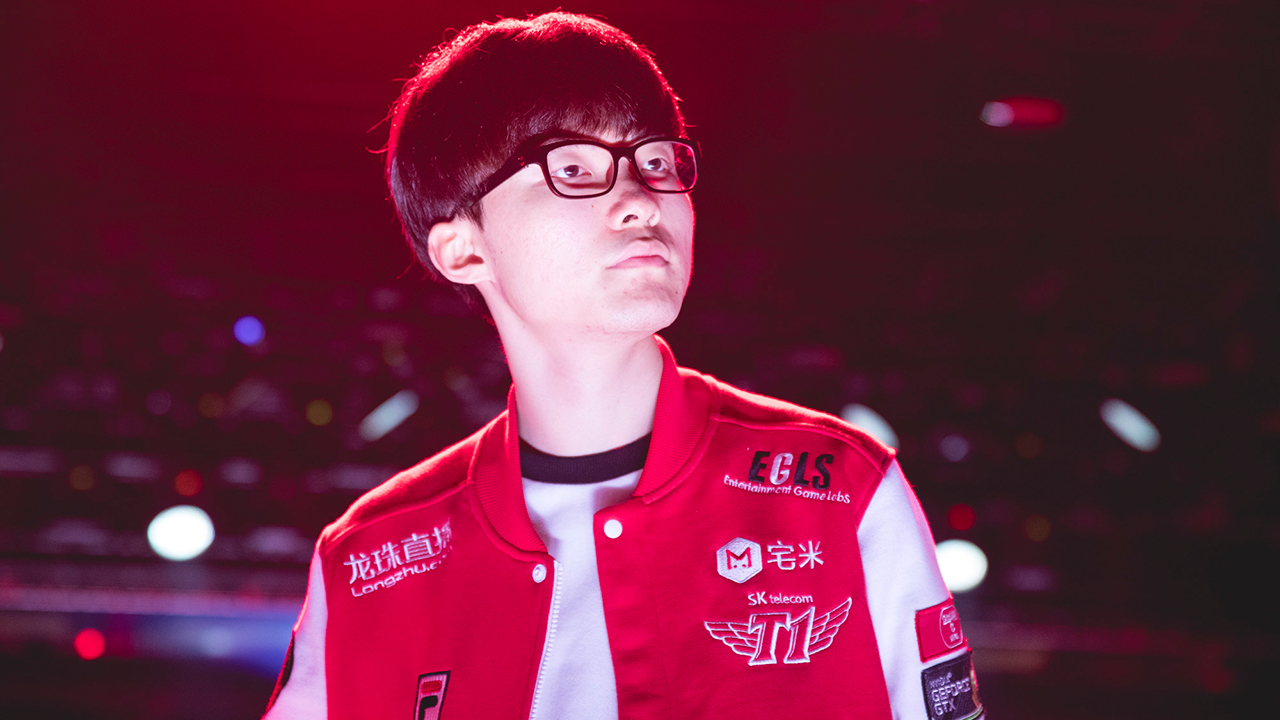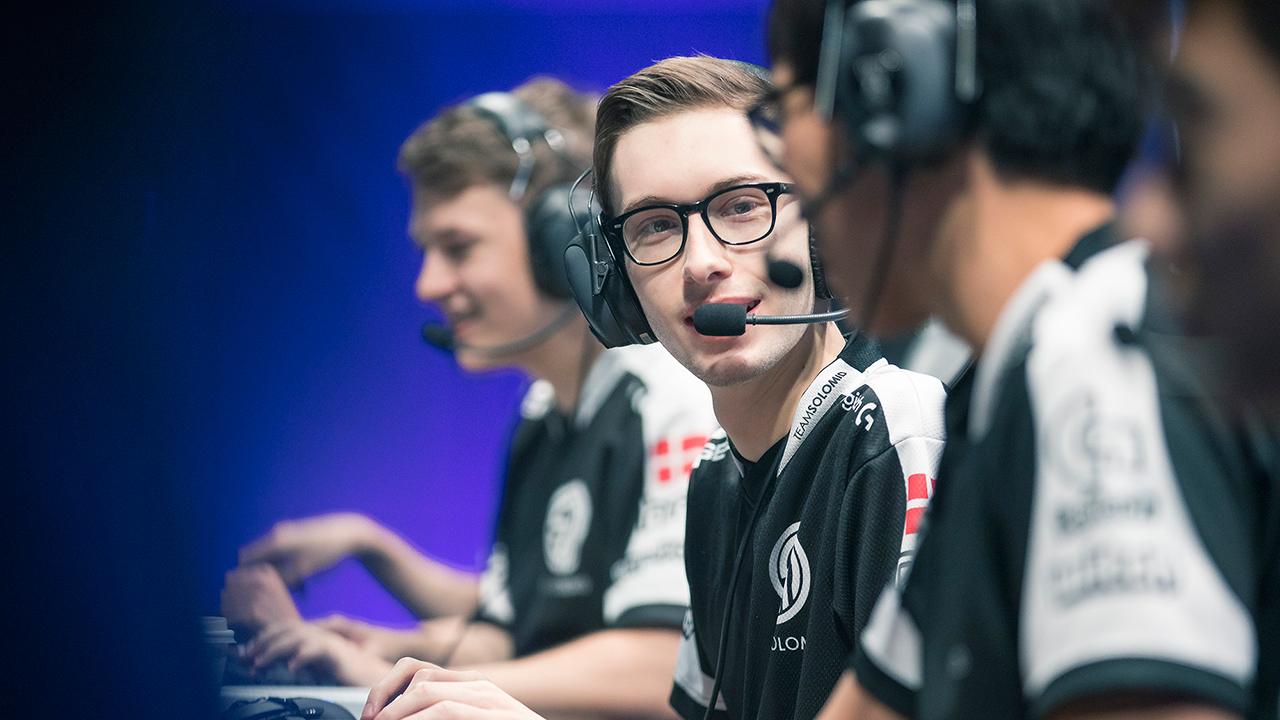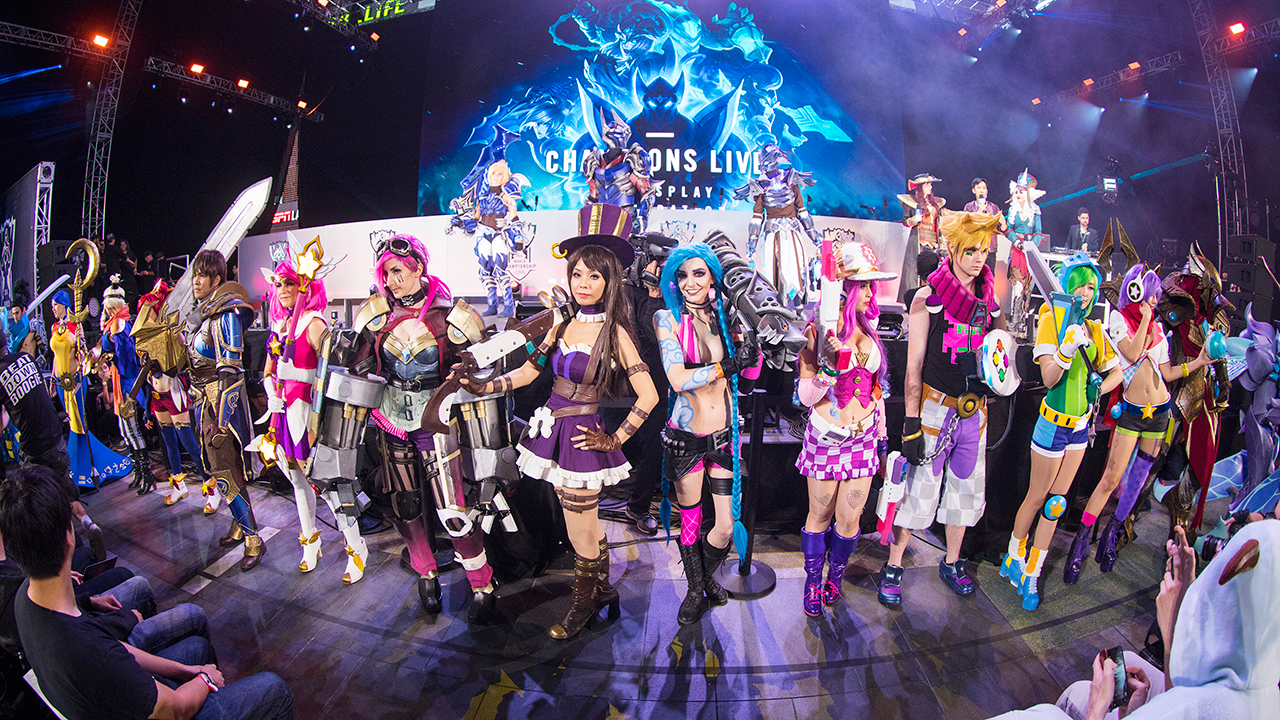Grouping up along the top lane, Team Dignitas heads downhill like a landslide toward the Team Epik Gamer base. Jungler Jatt on Trundle leads the charge, initiating on the inner turret which quickly melts down when his teammate Imaqtpie (read: “I’m a cutie pie”) lands the final blow with his Vayne.
Epik camps out on the outskirts of their base near their inhibitor turret. As soon as Dignitas is in range, Epik top-laner Westrice launches an attack at Jatt and the minion wave behind him. The Dignitas jungler retreats temporarily while Imaqtpie takes some pot shots at the turret. Then Dignitas moves back, regroups, and goes in again.
This time Jatt dives toward the turret, making himself a distraction as Epik’s ADC Dyrus launches the Bullet Time ultimate attack of his character, Miss Fortune, in a last-ditch attempt to push back the Dignitas tide. For a brief moment it looks like it’s going to work, but then it backfires. Dan Dinh gets caught too early throwing Epik’s defence strategy into disarray. From there, it’s absolute decimation. Dignitas rolls onto the Nexus turrets, and, with only Crumbzz surviving the bloodbath, Epik calls on the surrender, conceding the championship.
The bespectacled Jatt takes off his headset and looks out to the sparse but enthusiastic crowd inside the Circus Maximus casino theatre—a place normally reserved for the likes of bygone pop acts like Boyz II Men and New Kids on the Block. It’s October 2011, and Jatt and his four Dignitas teammates—all decked out in black and yellow hoodies—have just clinched the final at this four-day League of Legends (LoL) tournament in Atlantic City, winning a $10,000 purse. It’s Jatt’s first big payday as a pro gamer. Half a decade later, he’ll be one of the most recognizable faces in the runaway world of esports.
(Click on coloured links throughout the story for explanations of LoL terms. Colours correspond to definitions in glossary below.)

From the coin-op days of “Pac-Man” to serious, living-room experiences like “The Last of Us,” video games have evolved to where they now duke it out against—and often topple—film and television in the fight for people’s leisure time and money. They long ago left the toy section of the department store. Now they’re steadily making their way to the sporting goods area.
Gaming today is played at elite levels, with the top players competing in salaried leagues and annual tournaments for huge purses. Millions of people around the world stream their virtual battles, and tens of thousands fill arenas and stadiums to watch them compete live. There’s a massive audience out there that’s just as enthusiastic about SK Telecom T1 (SKT) mid-lane superstar Lee “Faker” Sang-hyeok as hockey fans are about Toronto Maple Leafs rookie sensation Auston Matthews.
That’s how Joshua Leesman—a.k.a. Jatt—got started in esports. Growing up about 400 kilometres southwest of Calgary in Cranbrook, B.C., Leesman divided his passion between the big four sports—his teams were the Calgary Flames, Los Angeles Lakers, Chicago White Sox and Oakland Raiders—and video games. Leesman was 22 when LoL first came out in 2009, and as the game’s popularity started to soar—more than 67 million people play the game every month, according to 2014 statistics provided by the game’s creator, Riot—he spent hours upon hours practising and reviewing video of the top players, trying to emulate what they were doing.
He quickly shot up the ladder as an elite-level jungler, and began his pro career in 2010 with a little-known team named Disciples of the Gr8 Whale. In June 2011, he jumped to Rock Solid, and two months later he was a member of Dignitas after it bought Rock Solid’s well-regarded LoL team roster. He had recently completed an electronic engineering degree at the Northern Alberta Institute of Technology and he had to make a choice: Pursue a career in engineering, or take a chance as a pro gamer?
He opted to roll the dice—and as his career began to take flight so did the industry.

According to Gameloco, which gathers statistics on Twitch, viewers spent over 172 million combined hours watching the three major esports—LoL, DOTA 2 and Counter-Strike Global Offensive (CS:GO)—in the month of October alone. Industry analyst Newzoo has reported that, among millennial men in the United States, esports is just as popular a spectator sport as the National Hockey League and Major League Baseball: 22 percent of those they polled frequently watch esports and MLB—a slightly smaller percentage frequently watch the NHL.
“The maturity of the audience is going to continue to grow,” says Leesman. “Currently, the fan base of esports is still relatively young. I’d say the majority of fans are between 15 and 30. But the people that were watching esports 10 years ago are still watching, and I don’t see any reason for them to stop.
“Think of the National Basketball Association in the 1970s. Not too many people were watching it, but it had a core fanbase; as that fanbase grows older, they remain fans. And when new fans come to the game, they [stay].”
The growth of esports has been helped by the advent of Internet streaming and the ability to rewatch almost any match on YouTube. However, what has aided the development of the industry most is the uber-popular League of Legends Championship Series (LCS), LoL’s official league, launched in 2013 by Riot. The LCS nets 2.3–3.8 million views per North American (NA LCS) series streams and 1.7–2.5 million for their European ones (EU LCS), with the world championship finals doing massive numbers: In 2015, the final match was watched by 36 million people; this year’s final, between South Korean teams SKT and Samsung Galaxy, at Staples Center, likely drew even more viewers.
This viewership has translated into a pay structure in which players earn $12,500 per split at minimum, with chances to earn even more should they make the playoffs or reach the coveted world championships, which recently handed out a little over $5 million in total prize money to 16 teams—$2 million of it going to the champions, SKT.
Other esports events hand out even bigger money. This past summer, “The International” DOTA 2 tournament awarded a total of $20.7 million, with first-place Wings Gaming winning $9.1 million.
Esports has evolved into big business so, of course, some of the richest people in the world have begun buying in. Coca-Cola and American Express are both official sponsors of the LCS. Sports teams have begun investing as well—European clubs Manchester City, Paris Saint-Germain, Valencia, Sporting Portugal, and FC Schalke have signed players for various games, and the NBA’s Philadelphia 76ers have recently acquired Dignitas and Apex Gaming, to name a few.
Individual athletes are also jumping aboard. Boston Celtics forward Jonas Jerebko purchased the rights to CS:GO team Renegades; former NBA star Shaquille O’Neal invested in NRG Esports; his old Los Angeles Lakers teammate Rick Fox bought Gravity Gaming and renamed it Echo Fox; and an investment group comprised of Magic Johnson, Golden State Warriors co-owner Peter Gruber and Washington Wizards and Washington Capitals owner Ted Leonsis bought the controlling interest of storied multi-esports organization Team Liquid.
Meanwhile the gamers themselves are hunting for any edge—physical or mental—to stay ahead of their peers.
“The best comparison I can [make] is to the athletes I’ve coached,” said Weldon Green, a professional sports psychology trainer who has worked with the Finnish national swim team and now coaches the NA LCS champions Team Solomid (TSM). “These people sitting beside me, they push themselves. They show up every single day with enough intensity to not only compete with the kind of sacrifice you see coming out of Olympians and people with really long professional careers, but to injure themselves in terms of competitive stress and force and tiredness on their brains and bodies.”
Specialized mental trainers like Green have become increasingly common among esports teams, adding to staffs that normally feature a team manager, analysts whose job is to break down tape and act as pro scouts in traditional sports, and coaches who focus specifically on team tactics.
“I think every team [scrimmages] between six to nine hours probably about five, six days a week,” said TSM team captain Soren “Bjergsen” Bjerg. “I haven’t personally found a way where I can improve without just spending more and more time. I think it all came from Korea where they were practising 15 hours a day and then our team was like, ‘Well, if we want to beat the Koreans, we have to practise just as much.’ So, we pretty much practise to the point of burnout.”

But as much as it has grown, the esports industry still has considerable cracks in its foundation that must be filled.
It’s visible in the inherent lack of regionality. Pro sports teams are normally affiliated with a certain city or area. This isn’t the case when it to comes to esports, making loyalty trickier to breed. If a would-be fan doesn’t already know a little bit about the players, teams and storylines, it can be difficult to jump in.
A larger problem however, is the number of games that can be considered esports.
As it currently stands the big ones are LoL, DOTA 2 and CS:GO. The first two fit under the multiplayer online battle arena (MOBA) umbrella, and can look similar to each other. Among secondary titles are Heroes of the Storm and Smite (also MOBAs), Overwatch, Halo and Call of Duty (first-person shooter titles like CS:GO), Hearthstone (a card game) and fighting games like Street Fighter (a genre unto itself with its own multiple sub-genres and games). Factor in that different leagues feature similar sports, and games of the same genre differ vastly in the way they’re played, and it can all become overwhelming.
Riot has managed to solve some of these issues, mainly by building excitement around their players through dedicated media exposure and merchandising. The LCS has successfully driven home the narrative that South Korean player Sang-hyeok, a.k.a. Faker, is the best player in the world—maybe of all time. It’s a story that sticks with an audience.
“It’s still players, it’s still stories, they’re still overcoming struggles,” Leesman said of the LCS’s appeal.
Riot has its own studio in Los Angeles and have hired entire commentary and analyst teams. Video features, advanced stat-tracking for all their matches, encore presentations of their live-streamed games quickly uploaded to YouTube—all of this has helped the LCS become the best-known and most watched “league” in esports.
DOTA 2 creator Valve has also found success with “The International,” with players making in-game purchases to contribute to the tournament’s overall prize pool. Next year Riot will be adopting a similar crowdfunding method for its LCS world championships, hoping to make the game even more popular and lucrative.

It’s a late August weekend in Toronto and the Air Canada Centre is packed with screaming fans for both days of the North American LCS finals. Everywhere you look young men and women are decked out in Teemo hats, cosplaying as their favourite LoL character, wearing jerseys with the likes of “WildTurtle” and “Biofrost” written on the back and holding delightfully obnoxious signs with the latest meme plastered all over them—lots of Harambe jokes—which event organizers encouraged them to make with the blank pieces of bristol board and markers that were being handed out in advance of the match.
For Leesman, it’s a validating moment. Five years ago, he decided to leave his gaming days behind and take a job with Riot as a tester for LoL. When the LCS launched, he was given a shot as a “shoutcaster.” Since then, he’s dug into his inner sports fan to try to emulate the likes of NBC’s Al Michaels and Cris Collinsworth. Today Leesman, still called Jatt by LoL fans, is best known for his “Team Fight Breakdown” segments, in which he analyzes the x’s and o’s of a fight in a particular LCS game.
Although he’s in something of dream role—“It’s like finding a unicorn, to find a job in esports,” Leesman says—when he quit as a pro, it seemed he had mixed feelings.
“I am heavily invested in the success of our League of Legends team and because of that I have decided to step down,” Leesman wrote in December 2011, announcing his departure from Team Dignitas. “Due to real life commitments and time constraints I can no longer keep up with the rigorous practice schedule required to be a pro gamer.”
At 29, Leesman is likely already past his prime as a gamer—pro players don’t usually last beyond 30 because of slower reaction times and mental stress. And Leesman feels he can make a far more meaningful impact on esports as a commentator because of the greater reach he’s afforded. So he traded a headset that allowed him to communicate with his teammates for one that let him speak to the world. The thousands of hours he poured into LoL paid off in the end. But with the industry blowing up around him, it’s tough not to wonder just how much money and international prestige could he have earned had he stayed in lane just a little while longer before deciding to hit recall?

GLOSSARY
Confused by the unique language of esports? Here’s a handy glossary of terms that will help you navigate this story. Each term is colour-coded for your convenience.Lanes and bases: League of Legends games are always played on a map called “Summoner’s Rift.” This map is divided into three lanes (top, mid, bottom) with two main bases on either end where both teams start from and can “recall” to with the press of a key no matter where they are on the map. Each lane features an outer and inner turret while the bases have inhibitor and Nexus turrets. The objective of the game is to penetrate the opposition’s defences and destroy the enemy Nexus. The Nexus spawns creatures called minions that storm down each lane and will attack the closest enemy to them (be that a turret, an enemy minion or an enemy player). They can help players attack the enemy should enough of them be present, but their primary function is as the main resource players use to power up their characters by defeating them.
Positions: There are five positions in League of Legends: Top-laner, jungler, mid-laner, attack damage carry (ADC) and support. The top-laner begins the game in the top lane and usually plays a more resilient, or “tankier,” character than the rest of the team. The jungler plies his/her trade in the in-between forested areas of the map called the jungle. Within the jungle there are monsters who are neutral to both sides, so instead of trying to get stronger using the minions in lane, the jungler defeats these monsters to power up. The mid-laner takes the mid lane and usually picks a character that provides long-range magic-based damage. The ADC plays the bottom lane, normally picking a character that dishes out high physical damage, but has lower resilience. Finally, the support is there to keep the “glass cannon” ADC alive with a character that will usually heal or do something to set up the ADC’s attack.
Click here to return to the top of the story
Gamer aliases: In esports most players are better known by their gaming alias or gamer tag than they are their real name, “Jatt,” for example, or “Imaqtpie.”
Champions: While players are called by their alias in game, across all esports the people they control are game characters. In League of Legends, these characters are called “champions” and they each boast special abilities and attacks, including something called the ultimate attack, which is that specific character’s strongest ability. The champions of League of Legends are a big reason for the game’s popularity and have resulted in special merchandise based off of them such as plush dolls and hats. So popular are these champions that people even dress up, or “cosplay” as the characters at events.
Ladder: Across most video games, the ranking system is called the “ladder.” In League of Legends’s case the most popular way to climb the ladder is through solo queue, a mode that teams up with four strangers against another team of five strangers. There are seven ranks a player can reach: Bronze, silver, gold, platinum, diamond, master and challenger. Should a person reach challenger there’s a chance he/she will be scouted to go pro.
Click here to return to the top of the story
Twitch.tv: The most popular video game streaming service in the world. Most esports tournaments and events are broadcasted via Twitch, and even more video game-related video content is streamed on the content everyday.
LCS splits: The LCS season is cut into two eight-week “splits” that take place in spring and summer. A post-season is played at the end of each split that help determine points for the world championship qualifiers that follow the end of the summer split.
Shoutcaster: Esports broadcasters are called shoutcasters, or just “casters” for short. The term comes from the Internet audio streaming software SHOUTcast. This was the software used by the original esports commentators and even though it’s not as widely used anymore, the term has stuck.




